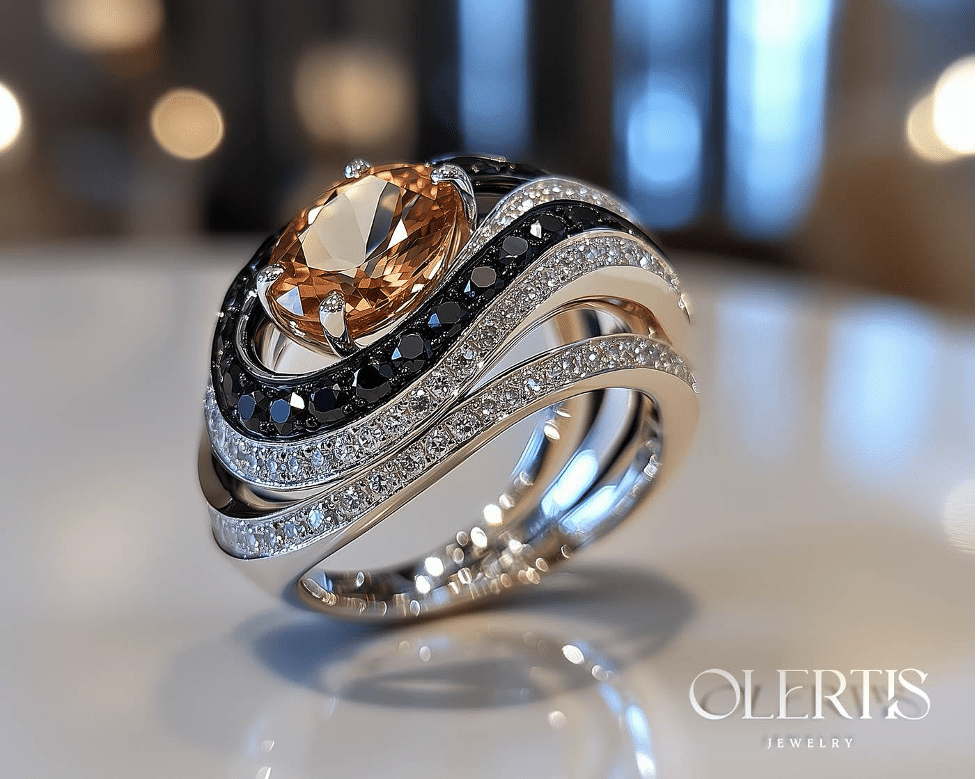
Have you ever wondered why gold isn’t always the same yellow color, even though it’s the same chemical element that you see in different jewelry pieces? How possibly can gold appear white, rose, green, or black? If you want to make your custom ring a one-of-a-kind item, it’s important to consider not only its design but also the aesthetic properties of your gold alloy. Different purities can transform gold’s appearance and its physical properties. Let’s consider the most common types of gold alloys that can be used in your personalized ring.
A Short Guide to Understanding The Karat System and Gold Purity
Jewelers measure the purity of gold in karats. They have a 24-karat system, with 24 representing the highest gold content in the given volume. If gold is 100% pure, it has a reddish-yellow hue and is malleable. Jewelers often mix gold with other metals to create alloys of different purity and improve the final product’s durability. Now, let’s see the types of gold according to the karat system with the purity percentage mentioned in brackets:
● 24 karat (100%): pure gold with no additional metals;
● 22 karat (91%): has 22 parts gold and 2 parts other metal types;
● 20 karat (83.3%): consists of 20 parts gold and 4 parts alloy metals;
● 18 karat (75%): a popular alloy for fine jewelry that includes 18 parts gold with 6 parts other materials;
● 14 karat (58.3%): affordable and durable jewelry alloy with 14 parts gold and 10 parts other metals;
● 10 karat (41.7%): in some countries, 10 parts gold is the minimum content of gold for a jewelry product to be labeled as “gold;”
● 9 karat (38%): has 9 parts gold and 15 parts of some alloys and is often used in cheap jewelry.

The Way Alloys Can Transform the Color of Gold
If you are looking for a way to personalize your jewelry with a special gold hue, mixing metals in different proportions may be the way to go. Please consider the following alloy guide before making your final custom jewelry decision:
● Yellow gold is a mixture of gold with copper and silver which makes the final alloy much more durable than pure gold.
● White gold commonly includes metals like nickel, zinc, or palladium and has a silvery finish. White gold items are often covered with rhodium plating to make them even whiter to the point when they resemble platinum.
● Rose gold is an alloy with a considerable proportion of copper, which gives off a pink color. It’s most favored by romantics and those who like vintage items.
● Red gold is similar to rose one but contains even more copper, which contributes to the wonderful red color.
● Green gold is an alloy of silver and gold (in some cases, jewelers use cadmium instead of silver). The hue may be barely distinguishable and give off just a bit of earthy undertones.
● Black gold is achieved through various methods like oxidation or adding cobalt and chromium. It adds a bit of minimalistic edge to your pieces.
The Ring of Beauty Is a Joy Forever
Understanding these gold variations can help you choose the ideal color palette for your very own custom ring. Knowing about your piece’s purity can also be useful in deciding on your wearing practices. For example, higher karat golds will likely have a more saturated hue but won’t be scratch-resistant. Such pieces can be worn mostly on special occasions and should be handled carefully. On the contrary, alloys with less gold content might offer better durability that will prove indispensable for everyday wear.

The choice is always yours and it depends not only on your aesthetical or practical preferences but also budget considerations. Whatever color and purity you end up choosing, you can now make a well-informed decision. After setting on a particular alloy type, don’t hesitate to speak openly about your metal needs with your future jeweler. The specificity of your request may need great precision and care on the part of your jewelry maker. This is why it’s always important to trust your personalized ring creation only to professionals. With such companies as Olertis, you can always be sure that everything is up to your own standards no matter how specific they might be.